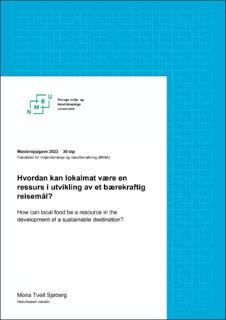| dc.contributor.advisor | John Peter Fredman | |
| dc.contributor.author | Sjøberg, Mona Tveit | |
| dc.date.accessioned | 2023-07-06T16:29:27Z | |
| dc.date.available | 2023-07-06T16:29:27Z | |
| dc.date.issued | 2023 | |
| dc.identifier | no.nmbu:wiseflow:6839585:54592383 | |
| dc.identifier.uri | https://hdl.handle.net/11250/3076834 | |
| dc.description.abstract | Sammendrag
Et bærekraftig reisemål henger tett sammen med et levende lokalsamfunn. Et sted hvor det er godt å bo og besøke. Mat er en viktig del av dette. Når man besøker et sted ønsker man å oppleve det som særpreger stedet. Konsum av lokal mat og drikke er en måte å oppleve autentisk lokal kultur (Hillel et al., 2013; Sims, 2009; Timothy & Ron, 2013). Undersøkelser fra Innovasjon Norge viser at etterspørselen etter autentiske matopplevelser øker. Turistene savner blant annet et godt lokalt kjøkken i Norge (Innovasjon Norge, 2021). Gjennom prosjekt ´Matnasjonen Norge 2030´ skal det jobbes for å utvikle et politisk rammeverk for Norge som matnasjon med basis i FNs bærekraftsmål. Et av målene i strategien er at Norge skal bli kjent som en matnasjon i internasjonal sammenheng, og at norsk matkultur skal være et synlig element i turistlandet Norge innen 2030. Ved å styrke Norge som matnasjon, styrkes også Norge som reisemål. (regjeringen, 2021) Det styrker også matglede, helse, stolthet og fellesskap i befolkningen, og gjør at nordmenn favner mer om sin egen matkultur.
Reiselivet kan og bør spille en viktig rolle for å nå FNs bærekraftsmål (Innovasjon Norge, 2023) Norge har som mål å redusere utslippet av klimagasser med 55 % innen 2030. (Regjeringen, 2022) Mat er en viktig del av reiselivet, og det er lite som har så stor effekt på bærekraftsmålene som mat. (FN, 2023) Satsning på lokalmat skal hjelpe Norge med å nå bærekraftsmålene, hvor miljømessige, sosiale og økonomiske forhold utgjør bunnlinjen.
I denne kvalitative studien undersøker jeg hvordan lokalmat kan være en ressurs i utvikling av et bærekraftig reisemål og styrke de sosiale, økonomiske og miljømessige sidene. Data er samlet inn ved hjelp av semistrukturerte intervju med lokalmattilbydere i Hardanger samt observasjon gjennom en smaksreise i regionen. Feltdagbok og bilder dokumenter dette.
Analysen tar utgangspunkt i Kamfjord (2019) sin teori om det helhetlige reiselivsproduktet, bærekraftsteorier samt Pine II & Gilmore (1999) sin teori om opplevelsesøkonomi.
Funnene viser blant annet at lokalmat styrker matkultur, stolthet, trivsel og identitet. Lokal matproduksjon bevarer kulturlandskapet og kan redusere transportutslipp. Den styrker også den lokale økonomien. Lokalmat har en sentral rolle i opplevelsesturisme og passer inn i alle element av det helhetlige reiselivsproduktet. Historiefortelling bidrar til økt produktverdi samt bevisstgjøring rundt mat og bærekraft. Dette kan inspirere turister til å tenke annerledes rundt sine egne valg og slik redusere eget miljøavtrykk. Sånn sett kan turisme redde verden. | |
| dc.description.abstract | Abstract
A sustainable destination is closely linked to a vibrant local community. A place where it is good to live and visit. Food is an important part of this. When you visit a place, you want to experience what makes the place special. Consumption of local food and drink is a way to experience authentic local culture (Hillel et al., 2013; Sims, 2009; Timothy & Ron, 2013).
Research from Innovation Norway shows that there has been a growing demand for unique food experiences. Among other things, tourists miss a good local cuisine in Norway (Innovasjon Norge, 2021). Through the project `Food Nation Norway 2030´, a political framework will develop Norway as a food nation based on the UN´s sustainable goals. One of the goals in the strategy is that Norway should be recognized as a food nation in an international context, and for Norwegian food culture to be a visible element in the tourist country of Norway by 2030. By strengthening Norway as a food nation, Norway is also strengthened as a travel destination. (Regjeringen, 2021) It also strengthens food enjoyment, health, pride and community in the populations and makes Norwegians embrace more of their own food culture.
Tourism can and should play an important role in achieving the UN´s sustainable goals (Innovasjon Norge, 2023). Norway aims to reduce the emission of greenhouse gases by 55 % by 2030 (Regjeringen, 2022). Food is an important part of tourism, and has a great effect on the sustainability goals (FN, 2023). Investing in local food will help Norway achieve the many of the sustainability goals.
This qualitative study investigate how local food can be a resource in the development of a sustainable destination and strengthen the social, economic and environmental aspects. Data has been collected using semi- structured interviews with local food providers in Hardanger and through observation. Field diary and photos documents this. The analysis is based on Kamfjord´s (2019) theory of the holistic tourism product, sustainability theories and Pine II & Gilmore´s (1999) theory of the experience economy.
The findings show, among other things, that local food strengthens food, culture, pride, wellbeing and identity. Local food production preserves the cultural landscape and can reduce transport emissions. It also strengthens the local economy. Local food has a central role in adventure tourism and fits into all the elements of the holistic tourism product. | |
| dc.language | nob | |
| dc.publisher | Norwegian University of Life Sciences | |
| dc.title | Hvordan kan lokalmat være en ressurs i utvikling av et bærekraftig reisemål? | |
| dc.type | Master thesis | |
